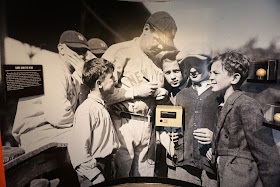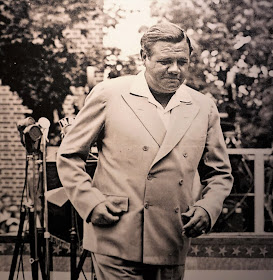I'm not a huge baseball fan. I'm not even a middlin' baseball fan. However, I AM a Babe Ruth fan. How could you not be intrigued by the Sultan of Swat? One of Baltimore's claims to fame is that it is the hometown of the world's most famous baseball player, and we decided it would be a shame to miss the Babe Ruth Birthplace and Museum.
How does a person go from being born in a row house in the working class area of Baltimore called "Pigtown" . . .
. . . to being named "Player of the Century" by Sports Illustrated? You don't have to love baseball to wonder about that!
George was an unchecked youngster, rarely attending school and, by his own accounts, drinking a lot of beer at a very young age when his father wasn't looking. At age seven he was labeled as "incorrigible" and sent to St. Mary's Industrial School for Boys.
As it turns out, that was probably a good decision. At St. Mary's he learned hard work and discipline, and it was there that we was taught the rules and techniques of the game of baseball by Brother Matthias Boutlier, a pretty good player himself. Brother Matthias' teachings about life and baseball would remain with George throughout his life. George one day would call him "the greatest man I've ever known."
George signed his first professional contract with the Baltimore Orioles in 1914 at age nineteen, and it was at his first spring training that George got his new name, "Babe":
The Babe hit his first home run in the Orioles training camp in North Carolina. It was his second time at bat, and to this day that home run remains the longest ball ever hit in the state. Everyone always talks about his home runs, but Babe was also a crack pitcher, and a lefty to boot. He quickly became a very valuable player, and after only four months with the Orioles, he was traded to the Boston Red Sox as a way for the Orioles to pay off some debts. (I'm guessing that's a decision they later came to regret.)
Pictures from Babe's professional career fill the rooms of the museum:
Babe used this bat in 1927, the year he hit 60 home runs:
Most of the records Babe set have since been broken, but the total of his offensive rankings remains the best in baseball. Altogether he set 206 hitting and pitching records during his 22-year baseball career. Here are some of them with their current status:
As a hitter:
- 8th all-time with a .342 batting average
- 1st in slugging prcentage (.690)
- 3rd in home runs (714)
- 4th in runs scored (2,174)
- 2nd in RBIs (2,213)
- 3rd in walks (2,062)
- 4th in extra-base hits (1,356)
- 1st in on-base plus slugging percentages (1.164)
- In 1916 he led the American League with a 1.75 ERA and 9 shutouts
- His record of 29 2/3 scoreless innings in World Series play was unbeaten for more than 40 years.
Babe was the stuff of legends. In the fifth inning of game three of the 1932 World Series, Babe stepped up to the plate and supposedly pointed to center field, then hit a home run straight to where he had pointed for the longest home run in Wrigley Field history.
Lots of sweet stories are told about The Babe's tender side, such as the promise he made during the 1926 World Series that he would hit a home run for his ailing friend "Little Johnny" Sylvester. As Johnny listened on a hospital radio, Babe hit THREE home runs.
Babe was always ready and willing to do anything for children.
Babe and his first wife Helen adopted a daughter. (Some believe she was actually his biological daughter by another woman.) After they divorced, he married Claire Hodgson and adopted her daughter, Julia. Although his womanizing was well-known, Babe appeared to adore his wife and two daughters:
. . . and they adored him:
It's hard to imagine the pressure Babe Ruth felt to perform. He was immensely popular, perhaps the most popular figure of his day:
The Babe was part of the 1934 all-star baseball team tour of Japan. He played every inning, hit thirteen home runs during eighteen games, and became a Japanese obsession. They called him "Beibu Rusu."
The Babe's Japanese kimono:
According to the museum, there are only 27 men who are members of the "500 Club," or players who have hit at least 500 home runs. Only three men have hit over 700 home runs: Babe Ruth (714), Hank Aaron (755), and Barry Bonds (762).
Ruth was absolutely everywhere, including, of all places, the dictionary. A new adjective was coined to describe someone who is prodigiously accomplished in something, or the state of being better than the best, majestic, or surpassing all others: "Ruthian."
Prior to this visit to the Babe Ruth Museum, one of the few sports-related venues that I felt was worth visiting was the Muhammad Ali Center in Louisville, Kentucky. Maybe that's because Ali reminds me a lot of Ruth. They were both boys from the wrong side of the tracks who, against incredible odds, pushed their way to the apex of their sports.
In late 1946, Ruth was diagnosed with an inoperable brain tumor at the base of his skull and in his neck. Because of his celebrity status, he was able to get state-of-the-art treatment and even went into a brief remission, but the path downhill was inexorable. Even though he got weaker and weaker, Ruth continued to make occasional public appearances. In June 1948 he appeared at the 25th anniversary celebration of Yankee Stadium, but he was so frail that he had to use his bat as a cane. A photo of Ruth from behind as he faced "The House That Ruth Built" captured America's love for this man and won photographer Nat Fein of the New York Herald Tribune the Pulitzer Prize--the first Pulitzer for a sports photograph.
Babe Ruth died just two months later in August 1948. He was 53 years old.
I ran across this video that shows The Babe's viewing and funeral, as well as some highlights from his career:
I challenge you to visit this museum and try to remain neutral about The Babe. It can't be done. I've joined the millions of Americans who adore and stand in awe of this big teddy bear.




































Very nice. I'm a sports fan and now an even bigger Babe fan.
ReplyDelete